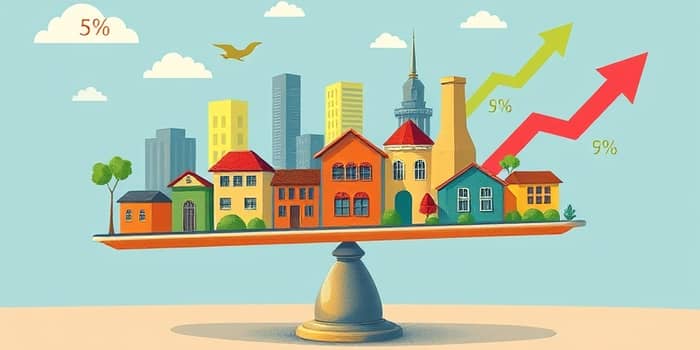
As the Federal Reserve keeps its benchmark rate steady at historic highs, U.S. housing markets are adjusting to a new reality of elevated borrowing costs. Mortgage rates now hover near 6.86%, reshaping buyer and seller behavior across the nation.
From record home prices to improved inventory levels, this comprehensive analysis explores how interest rate hikes from 2022 through mid-2025 are influencing sales volumes, affordability, and long-term trends.
After pandemic lows of 2.5–3.5%, the 30-year fixed mortgage rate surged through 2023 and stabilized at near 6.86% in June 2025. For borrowers, this means significantly higher monthly outlays. A $320,000 loan now carries a monthly principal and interest payment of about $2,099, compared to roughly $1,273 during the pandemic boom.
Even a one-percent uptick in borrowing costs can add over $250 per month, amounting to more than $90,000 over the life of a $400,000 mortgage. These shifts underscore why many prospective buyers have paused or delayed house hunting.
Despite dampened sales activity, U.S. home prices remain stubbornly high. The national median existing-home price reached $414,000 in April 2025, up 1.8% year-over-year, and nearing the June 2024 peak of $426,900.
Inventory has finally loosened: spring 2025 saw a surplus of 500,000 homes with 34% more sellers than buyers. This shift has ended widespread bidding wars and ushered in increased negotiating power for buyers.
The combination of higher rates and elevated prices has strained budgets. Mortgage payments that once consumed under 20% of a household’s take-home pay can now exceed 30%, particularly in hot markets.
Consumer sentiment reflects this squeeze. According to Fannie Mae, 74% of Americans believe it’s a bad time to buy a home. Meanwhile, rising shelter costs—up 3.9% in the past year—continue to drive overall inflation figures and influence Federal Reserve decisions.
History shows that high rates don’t stop Americans from buying homes. In the early 1980s, mortgage rates peaked near 18%, yet demand persisted. During the 1990s, with average rates of 8–9%, housing markets remained resilient, buoyed by life-cycle needs like marriage or job relocation.
This resilience during high-rate environments underscores that fundamental drivers, such as family formation and investment demand, often outweigh borrowing costs over the long term.
Most experts predict a modest recovery rather than a crash. If inflation continues to cool, the Fed may begin easing rates, lowering mortgage costs. However, a sudden wave of new buyers entering a market with constrained supply could reignite price surges.
Forecasts anticipate home prices to rise another 4.3% by April 2026. As NAR Chief Economist Lawrence Yun notes, getting shelter costs under control through increased housing supply will be critical to taming inflation and sustaining a balanced market.
*Figures as of June or most recent.
Whether you’re entering or exiting the market, strategic planning can turn challenges into opportunities. From locking in competitive financing to leveraging improved supply, proactive measures make all the difference.
In summary, the housing market is undergoing a balanced “reset” after the pandemic boom. Elevated rates have tempered runaway growth, yet fundamental demand and record equity levels remain robust. By understanding current dynamics—return to normalcy after overheating—and adapting strategies, participants can confidently navigate this evolving landscape.
References













